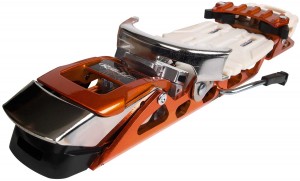Ever since their bobbled introduction to the market in 2007 the long term future of Rottefella’s new telemark norm (NTN) has been suspect. Had Rottefella been able to deliver the beta version of their binding to the public, things might have gotten off to a better start. Except they modified it before coming to market to ‘fix’ problems they knew would inevitably kill it anyway.
Thus, despite being at least two years late, they had a ‘classic’ introduction to the launch of a new system, full of promise and fraught with niggling shortcomings and problems with durability. Even so, the leading seller of NTN boots, Scarpa USA, has consistently maintained that for a new product introduction sales and growth of NTN are phenomenal. It may not seem that way compared to 75mm offerings, but it is easy to forget the plastic teleboot market had more than 15 years momentum when NTN was introduced.In response to growing frustration by US retailers dealing with excessive returns Rottefella extended their warranty from one to two years this past summer, effectively kicking the can down the road on durability issues. Meanwhile, they revised the frame that NTN is built around, potentially solving them. As with all things NTN, only time will tell.
The shortcomings of NTN are only evident when compared to the feature set of the mythical Tele Grail, particularly with regard to how well it tours. It isn’t light by a long shot, and while it does have a relatively free pivot, 30 degrees is a noticeable limit that is clearly inferior to other telemark touring bindings.
It isn’t quite a step-in binding, but when you consider how well it skis, or that it offers releasability, the importance of touring fades, especially if you spend the majority of your time close to the lifts. And if manufacturers were correct to insist that the majority of telemarkers do spend most of their time in-bounds why hasn’t the still sizable tribe of telemarkers switched en masse?
Let me suggest two reasons.
First, while many telemarkers may make most of their turns under the lifts, the heart and soul of telemarking remains in the backcountry. So even if they don’t spend most of their time in the backcountry, but especially if they do, uphill performance matters as much as downhill for most telemarkers. Besides, even if they only use the free-pivot occasional, it only takes a couple hundred steps to recognize that 30° is a limit. It is acceptable to NTN’s zealous converts, but a limit nonetheless.
Thankfully Rottefella has not only recognized the importance of touring, but has taken steps to address it. Besides making structural changes to the NTN binding for this season, they also gave it a name. Prior to the Eleven-12 season it was simply known as the NTN binding. But now it has a name, the Freeride, in order to distinguish it from its soon to be introduced sibling, the Freedom, optimized for the tour.
According to sources who have skied it the Freedom will have a free-pivot range of motion over 65° (they claim 90° but I don’t believe it). To chop weight, the bulk of the frame has been abandoned and with it a noticeable (but not dramatic) amount of torsional rigidity and it retains releasability and convenient latching in or exiting the binding. With any luck, this will provide the missing ingredient necessary for any technology to survive – choice.
That’s the second thing, to date there is no competitive offering. It has become evident that without a choice, without competition, new products inevitably languish because their finite feature limits have a corresponding limit in the marketplace. With choice, the range of appeal expands and the acceptance of the base technology grows. Witness the explosion of Alpine Touring bindings once manufacturers realized backcountry converts demanded a binding that resembled their in-bounds version, but allowed for free-heeled skinning. Or the number of different tech-fiddle bindings now that the basic Dynafit patent has expired.
And so it will be for NTN. Interest in NTN is growing dramatically each year, but the numbers are still small compared to the overall telemark market. Until they allow or encourage competition, NTN will languish. By at least offering a choice of bindings Rottefella has done all they can to insure the platform will survive until such time as they can’t prevent competition. In this writers opinion, the sooner other ideas enter the marketplace, the sooner NTN will truly overcome the limitations the 75mm norm holds telemark to.
Related Posts
Official Rottefella Freedom page
Alex Paul skinning w/Freedom prototype
Review of NTN Freeride
Circle back to TTIPS discussion
© 2011


27 pings
Skip to comment form
[…] Rottefella adds Freedom to NTN choices Rottefella's introduction of NTN has seen limited appeal. That may change with the introduction of a second NTN binding. Source: http://www.earnyourturns.com […]